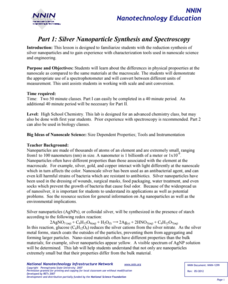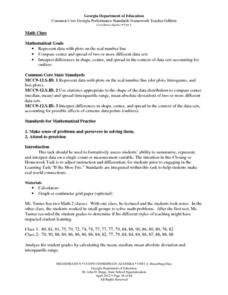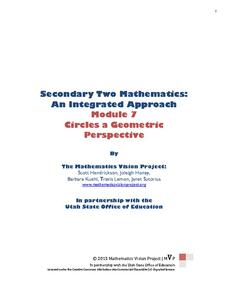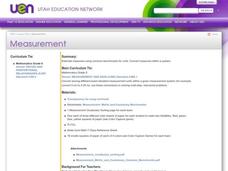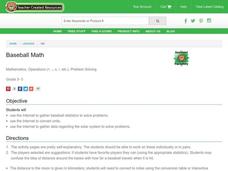Chicago Botanic Garden
Weather or Not
What is the difference between weather and climate? This is the focus question of a lesson plan that takes a deeper look at how weather data helps determine climate in a region. Using weather and climate cards, students decide...
Chicago Botanic Garden
Historical Climate Cycles
Scientists use ice core samples to obtain temperatures of the earth from 400,000 years ago! The third of five lessons instructs pupils to interpret historical climate data to see changes over time. In part I, participants interpret...
Space Awareness
Measure the Solar Diameter
Scientists could measure the diameter of the sun before they knew its distance. Scholars construct a simple mirror box to measure the diameter for themselves. They compare this measurement with the official size, listed in a...
Cornell University
The Galvanic Cell Game
Play a little game with your classes! Young scholars expand on their understanding of oxidation/reduction reactions in a game-based activity. They build a Galvanic cell with game pieces while learning about each component and their...
National Nanotechnology Infrastructure Network
Silver Nanoparticle Synthesis and Spectroscopy
Certain materials do not always maintain the same physical properties when they exist in the nanoscale. Help your classes to explore this idea through an experimental lesson. Scholars use spectroscopy with samples of silver solution...
Howard Hughes Medical Institute
Lactose Intolerance: Fact or Fiction
Around the world, about 2/3 of adult humans are lactose intolerant. Scholars work in small groups to discuss a few statements about lactose intolerance. Then, they watch a video on the topic and readdress each statement. Whole-class...
Georgia Department of Education
Math Class
Young analysts use real (provided) data from a class's test scores to practice using statistical tools. Not only do learners calculate measures of center and spread (including mean, median, deviation, and IQ range), but...
Willow Tree
Scientific Notation
Numbers that are very large or very small are difficult to express in standard notation. Pupils learn how to convert between standard and scientific notation. They also multiply and divide the numbers in scientific notation.
EngageNY
The Graph of the Equation y = f(x)
Math language? Set notation is used in mathematics to communicate a process and that the same process can be represented as computer code. The concept to the loop in computer code models the approach pupils take when creating a solution...
Inside Mathematics
Expressions
Strive to think outside of the quadrilateral parallelogram. Worksheet includes two problems applying prior knowledge of area and perimeter to parallelograms and trapezoids. The focus is on finding and utilizing the proper formula and...
National Energy Education Development Project
Exploring Hydropower
In 2006, about 20 percent of the world's electricity was generated from hydroelectric power. In the presentation, scholars review the water cycle and gravitational energy to begin to understand how humans harness the power of water. They...
Mathematics Vision Project
Circles: A Geometric Perspective
Circles are the foundation of many geometric concepts and extensions - a point that is thoroughly driven home in this extensive unit. Fundamental properties of circles are investigated (including sector area, angle measure, and...
Curated OER
Basic Drafting Skills
Students demonstrate the proper use of tools found in basic drafting. Using proper terminology, students identify tools and create Isometric and Orthographic drawings. Students convert Orthographic drawings into Isometric drawings and...
Curated OER
Measurement
Students explore the concept of measurement. In this measurement lesson, students discuss what specific measurement tools such as an odometer measure. Students recite a measurement poem. Students make a foldable with conversion units...
Curated OER
Baseball Math
Fifth graders complete activity pages. In this operations and problem solving lesson, 5th graders use the Internet to gather baseball statistics, solve problems and convert units.
Curated OER
Metric Units of Capacity - Homework 12.8
Upper graders convert liters and milliliters, choose the better estimates of capacity for objects, and choose the better unit to measure capacity. They solve eleven problems.
Curated OER
Metric Units of Length - Homework 12.7
In this metric worksheet, students fill in missing numbers in units of length comparisons, complete tables and write their rules, and solve 1 word problem. Houghton Mifflin text is referenced.
Curated OER
Customary Units of Capacity - Practice 12.3
In this units of capacity worksheet, students find missing numbers in comparisons, choose units to measure capacity of items and compare. Houghton Mifflin text is referenced.
Curated OER
Metric Units of Capacity - Problem Solving 12.8
In this units of capacity instructional activity, students read the word problems and solve the problems finding the metric units of capacity for each. In the 'use data' problem, students use the recipe to help them solve the problem.
Curated OER
"More Than One"
Help your class learn the spelling rule for adding -es to plural nouns and third-person singular verbs. The resource suggests using songs daily to reinforce the rules. The songs are contained in a Sing Your Way Through Phonics 2-CD set...
Curated OER
Blast the Fats
Students examine the fats found in foods. In this nutrition lesson, students identify the types and amounts of fats found in foods as they research food labels and the Internet. Students classify the fats and record their data.
Curated OER
Convert the Fractions to Decimals
In this fractions to decimals worksheet, students convert the given fractions to their decimal equivalents. Students complete 14 problems.
Curated OER
Fraction/Decimal Worksheet 1 - Fractions to Decimals
In this fraction and decimal worksheet, students change 9 fractions to their decimals equivalents. The answer key link does not work.
Curated OER
Converting Fractions to Decimals
In this Algebra I learning exercise, 9th graders convert fractions to decimals rounding to the indicated decimal place. The one page learning exercise contains six questions. Answers are not included.




